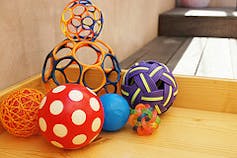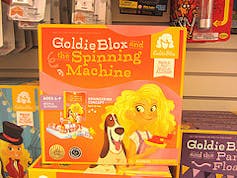Being a child in the 21st century is very different, and some would say more complex, than in previous times. What remains constant is that children love playing and that play is regarded as the most effective way of learning in childhood.
In play scenarios young children are being imaginative, creative, posing problems and solving them in contexts that are meaningful and engaging to them while learning about the world and ideas that shape it. With free play sessions increasingly being recognised as an essential component of quality early childhood programs, parents are eager to support this with appropriate props and educational toys.
Yet, everyone has a story about how their child enjoyed playing with the box that the toy came in, rather than the toy itself! And baby boomers lament how they used to play with sticks for wands, and old sheets for decorating cubbys that we used to scavenge from very creative sources.

So does this 21st century plethora of choices and constant claims that toys are educational really stack up? The brochures and websites implore parents to “check out these brain boosting and skill building infant learning toys […] for the developing mind” and say they have toys that “honour the creative process”.
No evidence is provided to support such claims and, in reality, the toys are expensive, and often limited in scope unless parents interact and teach their children the associated skills and concepts. In many instances they are in fact tied to franchises (Disney, Pixar) that basically want to promote their items with negligible concerns about learning or educational value.

For example, there are 14 toys promoted by the online parenting magazine as being the best educational toys for “brain boosting, skill building, and the developing mind” of infants and toddlers. A pull along caterpillar comes with the claim that it is “an imagination building toy that kids can use to enjoy hours of fun”. Yet, with no suggestions about what these might consist of apart from pulling it along.

Then, the robot puzzle which is very well made in good quality wood and colourful paint, says that it will allow the children to become skilled in matching pictures - with just three shapes. It will probably do this but its a lot to pay for something with only one right result to match the three shapes.

The educational value only comes from the parents interacting with their child, questioning them as they play and asking about strategies and providing them with knowledge about robots and caterpillars and taking them to see real ones as part of their daily lives.
The annual toy of the year awards provide insight into the toys that are regarded as the best in the industry. There are 15 categories with both the people’s choice and educational toy of the year in 2014 being awarded to Goldieblox and the spinning machine. In winning this prize the toy is deemed:
The best toy that through play helps children develop special skills and/or knowledge.
It was especially pleasing to discover that this company has as its stated aim:
GoldieBlox is a toy company out to inspire the next generation of female engineers. Construction toys help kids develop spatial skills and get them interested in math and science. For decades it’s been a boy’s club until now. GoldieBlox is an interactive book and construction toy starring Goldie, a kid inventor who solves problems by building simple machines. It’s time to build a new story so our girls can help build our future.
The great thing about this series of toys for girls is that they encourage girls to play with construction in a context of a story that will be appealing to them. It’s not about princesses that need to be rescued and all the items are not pink. The girls are able to construct various systems of cogs and blocks to create contexts for problem solving.

The awards did have a separate boy and girl winner category, won by a Despicable Me 2 action figure and rainbow loom (also from Goldieblox) respectively. The former was in fact from the movie franchise and as such provides limited opportunities for children to go beyond re-enacting scenes with characters that have pre-determined personalities.
So, while there are indeed inspiring companies that claim to support feminism, there would seem to be an overabundance of toys that are linked to particular franchises that not only maintain traditional gender roles but also restrict play, because they limit a child’s capacity to be creative with them. Hence, they can in no way be regarded as being educational.

Parents have to be involved in the learning
Parents and caregivers should not be duped into thinking that learning is going to spontaneously happen if they just leave the child with the toy. The role of adults in the play environment is critical.

It is important for parents to realise that young children need time to explore and play, and to understand that interacting with your child when they are playing is not only a significant opportunity for them to communicate with you in a conducive environment, but also provides a catalyst for using language which is so essential for effective understandings about the world and the communication of ideas to others.
Many parents seem to purchase toys and learning materials with the aim that children will play with them and learn, but also in order to keep the child occupied, so they can have time for themselves to do other things. While this might be the case with good toys, it is also apparent that this play time represents a significant opportunity to explore and talk to your child so that they are scaffolded in their explorations and provided with model language they can use and extend in other settings.
Playing with your children is an integral role for parents who wish to provide the most effective learning environment for their child. Parents might ask children questions like, What is this? What does it do? Or, What colour is this? Can you show me…? Can you tell me how many? They should also ask questions like What do you think will happen if…? And, Can you think of another way to build/open/create…?
Such interactions not only enable children to identify and locate things but also provide contexts in which they can think, suggest and test ideas in a non-threatening environment.
So as we approach Christmas, the biggest toy buying season of the year, parents need to be a bit creative themselves and relearn how to play, and more importantly how to support their children’s learning with open ended questions as they play together with their child. The ability of toys to help kids learn is more about how they’re used than what it says on the box.


